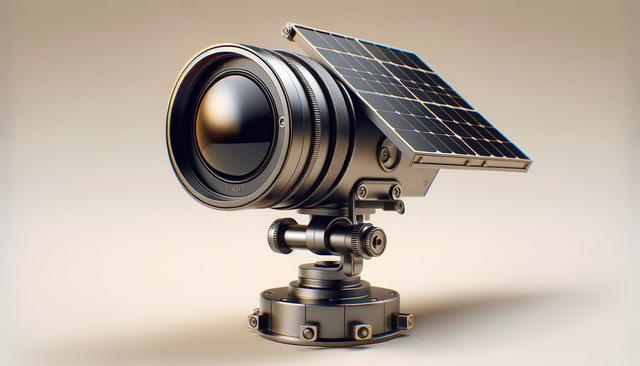What Makes Solar Cameras a Practical Choice?
Solar cameras are increasingly being adopted across residential and agricultural settings for one simple reason: they offer flexible and reliable security solutions without the constraints of traditional wiring. These devices are powered by built-in rechargeable batteries that are charged via solar panels, making them particularly useful in areas where installing power lines or network cables is impractical or expensive. Whether you’re monitoring a remote farm or enhancing your home’s perimeter security, solar cameras offer a practical alternative.
Still worried about “no power” or “too far network cables” for surveillance? Solar cameras eliminate these concerns by operating independently of the grid. They are ideal for:
- Rural or off-grid locations where electricity is limited
- Temporary installations or construction sites
- Areas prone to power outages
- Expanding existing surveillance systems without the need for additional wiring
Adopting solar-powered security not only reduces energy costs but also simplifies installation and maintenance.
How Solar Cameras Work
Understanding how solar cameras function helps clarify why they are gaining popularity. Each unit typically consists of a solar panel, a rechargeable battery, and a camera with wireless connectivity. During the day, the solar panel captures sunlight and converts it into energy, which is stored in the battery. This stored energy powers the camera during nighttime or cloudy periods.
The camera connects to your home’s Wi-Fi or a cellular network, enabling remote access through a smartphone app or desktop platform. Even if the area is isolated, some solar cameras use SIM cards to transmit data, resolving the issue of “too far network cables” for surveillance. Key features of most solar cameras include:
- Motion detection and instant alerts
- Night vision capabilities
- Two-way audio communication
- Cloud or local storage options
This combination of features ensures that users receive comprehensive surveillance coverage with minimal ongoing intervention.
Benefits for Homeowners
Solar cameras bring a host of benefits to residential users. They are especially useful for homeowners who want to secure their properties without increasing their energy bills or hiring professional installers. Since the cameras are not dependent on external power sources, they continue working during power outages, offering uninterrupted surveillance.
Still worried about “no power” or “too far network cables” for surveillance? With a solar camera, those worries fade quickly. Benefits for homeowners include:
- Quick and easy setup without drilling or wiring
- Environmentally friendly energy use
- Scalability – easily add more units as needed
- Remote monitoring from anywhere in the world
These qualities make solar cameras a reliable and user-friendly option for enhancing home safety and peace of mind.
Advantages for Farm and Rural Property Owners
For those managing large plots of land or agricultural operations, solar cameras provide a particularly effective solution. Farms often span wide areas where laying cables is not only costly but sometimes impossible. Solar cameras allow farmers to monitor livestock, equipment, and boundaries with ease, using sunlight to power the entire system.
Still worried about “no power” or “too far network cables” for surveillance? That’s a common challenge in rural areas, and solar cameras directly address it. Their advantages for farm use include:
- 24/7 monitoring of remote fields and barns
- Increased security for expensive machinery
- Real-time alerts for intrusions or unusual activity
- Minimal maintenance and long-term cost savings
Additionally, solar cameras can help improve operational oversight, allowing farm owners to check on activities without being physically present at each location.
Considerations Before Installation
While solar cameras offer numerous advantages, there are a few factors to consider before installation to ensure optimal performance. Location is key—solar panels require direct sunlight for efficient charging. Areas heavily shaded by trees or buildings may limit the charging capability and reduce battery life.
Also, consider the camera’s connectivity requirements. If your location lacks Wi-Fi coverage, opt for models that support cellular data. Evaluate battery capacity and storage options as well, especially if you need long-term footage retention or high-definition video capture.
Still worried about “no power” or “too far network cables” for surveillance? These concerns can be mitigated by choosing the right model and planning the installation carefully. Check for:
- Battery backup and energy efficiency ratings
- Weatherproof design suitable for your climate
- Warranty and customer support availability
- Compatibility with existing security systems
Taking these steps will help you maximize the benefits and longevity of your solar camera setup.
Conclusion: A Smart, Low-Maintenance Surveillance Solution
Whether you’re a homeowner seeking peace of mind or a farmer looking to protect your livelihood, solar cameras provide a smart, sustainable, and efficient way to ensure security. Still worried about “no power” or “too far network cables” for surveillance? These self-sufficient systems offer a practical solution that adapts to a variety of environments and needs.
By harnessing renewable energy and eliminating complex wiring, solar cameras stand out as a low-maintenance yet highly effective option. As more families and farms recognize their value, these devices are set to become a staple in modern security systems.







